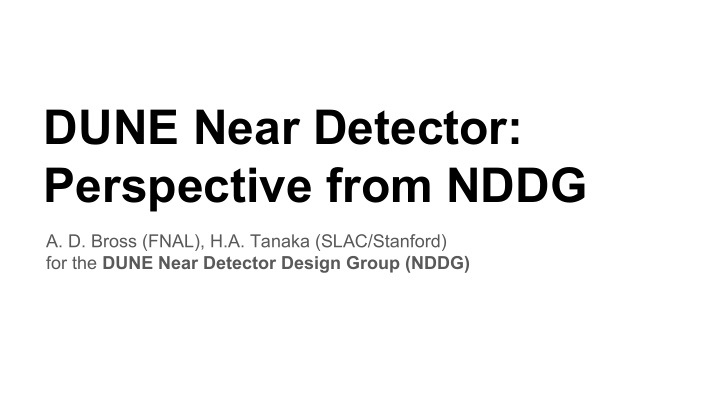



DUNE Near Detector: Perspective from NDDG A. D. Bross (FNAL), H.A. Tanaka (SLAC/Stanford) for the DUNE Near Detector Design Group (NDDG)
HISTORY AND ORGANIZATION ● Near Detector Design Group (NDDG) follows from the Near Detector Concept Study ● DUNE doc 8184 ● Highly recommended reading ○ Things have changed somewhat but not much ○ Explains much of the reasoning/assumptions that go into to the current design ○ Series of recommendations articulate the starting point for the design concept ● Not the intention of this talk to explain the design ○ The following talks will do this in ample detail
RECOMMENDATIONS ● Main components ○ Segmented LAr detector (“ArgonCube”) with/for: ■ Short drift distance (~50 cm) ■ Optically isolated LAr scintillation detection ■ Pixel readout ○ “Multi-Purpose Detector” (MPD) ■ Magnetized ■ High pressure gas TPC (HPgTPC) ■ 3D scintillating tracker (3DST) ○ DUNE-PRISM ■ Detectors moveable off-axis ● Evolution of design following report ○ 3DST is now a separate system (3DST-S) with magnetic spectrometer and calorimetry ○ MPD now includes ECAL and possibly muon detectors around the HPgTPC ○ LAr+MPD move for DUNE-PRISM ○ 3DST-S stays on-axis
DUNE-PRISM: LAr+MPD travel off-axis LAr: 7x5 array of 1x1x3m 3 modules 3DST-S ν MPD: Coils, ECAL, HPgTPC
NDDG Organization non-US interests: ● LAr: ○ Switzerland, Russia, UK ● MPD: ○ HPgTPC (UK) ○ ECAL (Germany, Italy) ○ Magnet (Italy, India) ○ Muon (India) ● 3DST: ○ CERN, Russia, South Korea, Spain
RELATION BETWEEN NDDG AND US-DUNE ND ● The design of the ND is the responsibility of the (international) DUNE collaboration through the NDDG ○ We must push forward with the current concept and develop/optimize it both technically and scientifically ○ It is essential for this effort to be scientifically driven and for the collaboration as a whole to “buy in” to the design, regardless of eventual contributions and roles. ○ Review by the Long Baseline Neutrino Committee (LBNC) is a critical part of the process ● Understanding the US effort is critical to the success of both the design and eventual construction of DUNE ND ○ Resources everywhere (not just in the US) are (highly) uncertain and constrained ○ Highly targeted and leveraged contributions will be essential towards a successful US ND effort and the DUNE ND effort overall
TIMELINES/MILESTONES 1 st Executive Summary Submission to LBNC for review ● 3 May: ● 27 May: Updated version of ES to LBNC ● 20-24 May: DUNE CM – May 20-24 ● 24 May: Written feedback from LBNC ● 25-27 May: DUNE ND WS – May 25-27 ● 2 June: Slides for LBNC ND review delivered to LBNC ● 4 June: LBNC ND Review ● End 2019: End of 2019 ● End 2020: ND TDR
Recommend
More recommend